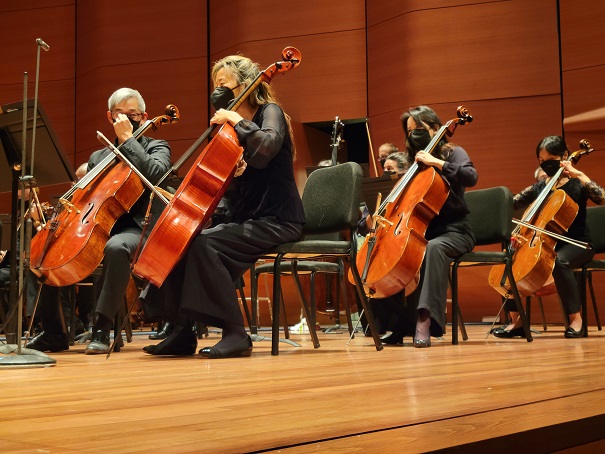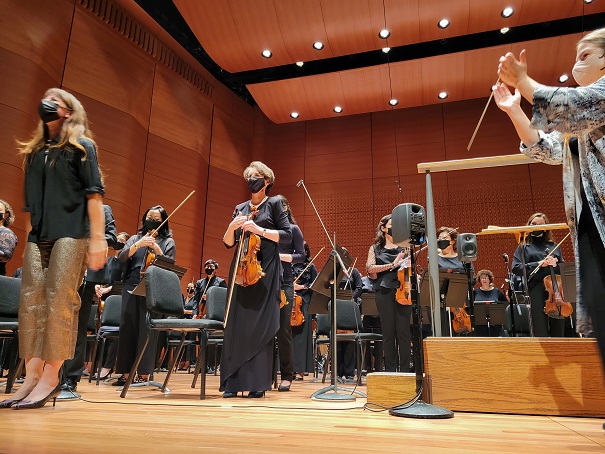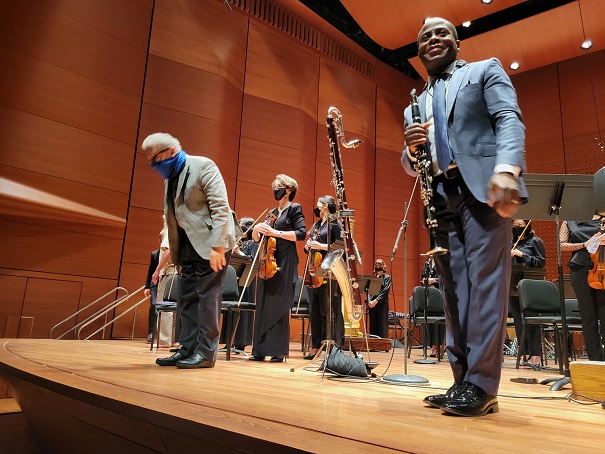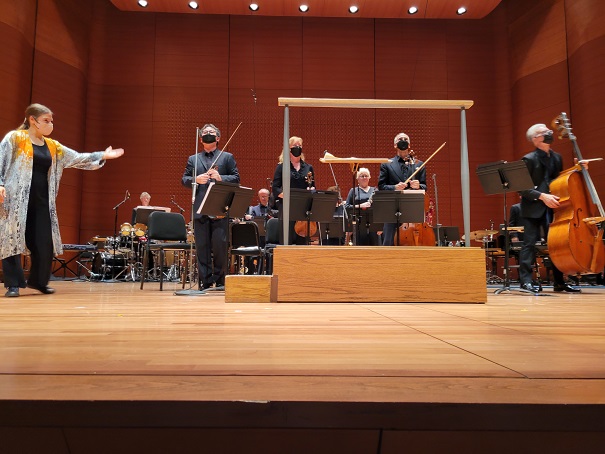Concert Diary: An American Triptych with the New York Philharmonic
October 22, 2021
New York, N.Y.
It’s not unusual for orchestras to premiere new works by living composers. But all too often these works don’t get subsequent performances. They don’t become part of the repertoire that orchestras draw upon when fashioning programs.
The New York Philharmonic’s program this week is different: Called An American Triptych, the program features three dynamite works by prominent American composers Missy Mazzoli, Anthony Davis, and John Adams, all under the baton of Finnish conductor Dalia Stasevska making her New York Philharmonic debut.
The orchestra has now moved to Alice Tully Hall while their permanent home (just next door) is being renovated. Alice Tully is used mostly for soloists and chamber music, so the stage was extended outward to accomodate the orchestra. Our seats last night in Row G became the front row just left of the conductor’s podium! We had a good view of the first violins and the cellos, but not much of the rest of the orchestra. Here’s some of the cello section getting ready for the concert:
The concert began with Missy Mazzoli’s Sinfonia (for Orbiting Spheres) from 2014 and revised in 2016. The composer has said that she set out to make music in the shape of the solar system, and there do indeed seem to be swells of sound and even Doppler effects that suggested swirling planets (if there was actual sound in the depths of space). But I stopped listening for those types of connections and just accepted the romantic lushness of it all. Mazzoli creates quite gorgeous textures in this work with repetitive figures and darting phrases and melodica drones, and at times I thought I was taking an underwater journey.
But enough of programmatic associations! As just pure music, this is a beautiful work. Missy Mazzoli lives in Brooklyn, so she was present for the performance and joined Daria Stasevska on stage during the applause section of the program:
Next up was Anthony Davis’s You Have the Right to Remain Silent, inspired by an incident when Davis and his wife were stopped by a police car on the way to a concert where he was performing. Supposedly he resembled a robbery suspect, but Davis and his wife were well aware that such altercations between police and African-Americans sometimes end very badly. The composition dates from 2006 but was revised in 2011.
In structure, You Have the Right to Remain Silent is a four-movement concerto for clarinet and orchestra, and the four movements correspond to a traditional fast-slow-scherzo-fast architecture. But this is a political work as well a musical one. The clarinet part represents the protagonist of the confrontation, and the orchestra becomes everything else: the police, the situation, the system. At certain points during the performance, various groups of orchestra’s musicians orchestra chant out the famous words of the Miranda warning.
On the clarinet was the much beloved Principal Clarinetist of the New York Philharmonic, Anthony McGill. Davis also requires a Kurzweil synthesizer, which was played by composer and musician Earl Howard.
The first movement is called “Interrogation” achieves a driving intensity with a drum kit adding to the rhythm. The second movement is a generally slow lament entitled “Loss” where the clarinetist switches to a large contra-alto clarinet, whose sounds (I believe) are sampled and distorted by the Kurzweil synthesizer. The third movement ("Incarceration") features skittery clarinet and more of the Miranda warning chopped into pieces. The final “Dance of the Other” is more relaxed, falling into a groove. Nothing of the political situation is resolved, but Davis has survived yet another case of mistaken identity.
Anthony Davis lives in San Diego, but he was also present for the concert and joined Anthony McGill on stage during applause. Between them is the large contra-alto clarinet:
The oldest work on the program was John Adams’ Chamber Symphony of 1992. This is Adams at his most whimsical. The work was supposedly inspired when he was studying the score of Arnold Schoenberg’s Chamber Symphony while his son was enjoying the frenetic music of 1950s-era cartoons. But with the works rhythmic and jagged textures, I hear more Stravinsky than Schoenberg
Despite being a trip into crazy-town — and I mean that in the most complimentary way — Chamber Symphony has a traditional three-movement fast-slow-fast architecture. The second movement slows down to a steady bass beat with much lighter textures, until the third movement (called “Roadrunner” as a cartoon homage) is fired out of Acme cannon with exhilerating blistering speed, though pausing somewhat for a wonderful violin and percussion cadenza.
Here’s Dalia Stasevska on the left with the relatively small ensemble for the Adams Chamber Symphony:
Just this little taste of the variety and strength of modern American music is not enough. We want more!



